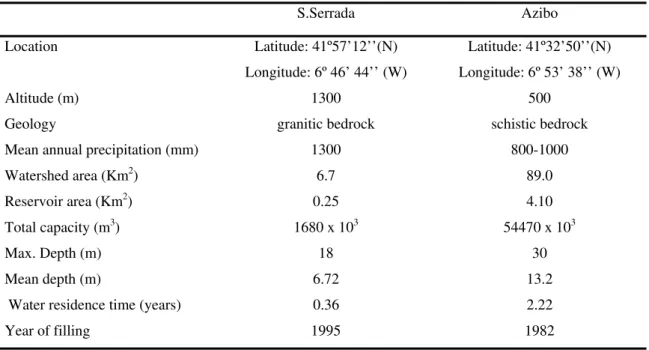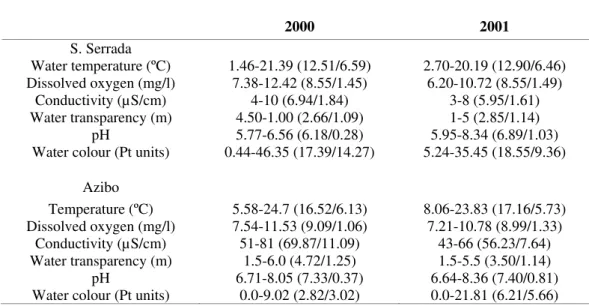Reservoirs: Mirrors of the surrounding landscape?
A.M. Geraldes
1*& M. J. Boavida
1
CIMO, Escola Superior Agrária do Instituto Politécnico de Bragança Campus de
Santa Apolónia, Bragança, Portugal
2
Centro de Biologia Ambiental, Departamento de Biologia Animal, Faculdade de
Ciências da Universidade de Lisboa Campo Grande, Portugal
Abstract
To assess in what extent the environmental quality of aquatic systems reflect landscape features several water quality parameters were determined in two reservoirs. Concomitantly, the surrounding landscape was characterized and the existing potential sources of phosphorous and nitrogen runoff were identified and when possible estimated. Located in a mountainous area with negligible direct human influence, it was expected to find lower amounts of suspended organic matter and nutrients in Serra Serrada Reservoir. Water level fluctuations caused by intensive human water use, grazing and frequent land fires in the surrounding landscape can explain the unexpected high values of the mentioned parameters. In Azibo Reservoir the factors with greatest influence on water parameters seem to be allochthonous sources of nutrients originated from agriculture and grazing in the catchment area and recreational activities. However, in this particular case the potential sources of nutrients could have been minimized by the patchy structure of the surrounding landscape.
Keywords: Landscape, Water quality Land use, Phosphorous and Nitrogen sources
1. Introduction
Pressure caused by human activities in the catchment area and reservoir vicinity generally leads to an intensification of surface runoff, causing an increase in eutrophication, thus threatening water quality. Runoff rates depend mainly on land use, vegetation cover and landscape mosaic. The present study was carried out for two years on S. Serrada and Azibo reservoirs located at the Portuguese part of the international Douro catchment basin, in Trás-os-Montes region (NE Portugal). Location, morphological and hydrological characteristics of both reservoirs are shown in Table 1. Serra Serrada Reservoir was built to supply water to the city of Bragança and to generate hydroelectric power. Consequently, pronounced water level fluctuations occur, ranging between 8 and 10 m. Direct human influence on this reservoir impoundment is considered negligible. There are no villages, there has been no agricultural activity for approximately 20 years and recreational activities are not significant. However, in the catchment basin grazing can be very intense in summer months. All over the year there are only about 200 sheep grazing in the S. Serrada catchment, yet from May to August about 5,000 sheep from lowlands are transported from the surrounding lowlands to graze in the catchment and reservoir surroundings. Consequently, this area is very often subjected to wildfires which are mainly induced by shepherds to obtain better graze. Azibo Reservoir was built for water supply and irrigation, but those activities are not significant and the reservoir is used mainly for recreation. In Azibo direct influence of human activities is greater during summer when reservoir and
*
surroundings are used by about 10,000 people for recreation such as swimming, camping and boating. Angling is also an important activity. The watershed area is occupied by meadows (1286 ha), woodlands and scrub (935 ha) and extensive agriculture (2235 ha). The latter is found all over the year and the main crops are olives (657 ha), chestnuts (650 ha), cereals (546 ha), vineyards (144 ha) and potato (85 ha). In the reservoir shore there are intensive crops, which are less than 1% of all crops (INE, 1999). Extensive grazing also occurs in this drainage basin. In Azibo catchment area there are several small villages. The total of inhabitants is about 1,500 and most of them are more than 50 years old (INE, 2001). Passing nearby and over of one stream that feed this reservoir there is a highway, IP4. In this highway the average daily traffic volume is 6,000 vehicles (Barbosa and Hvitved-Jacobsen, 1999). There is no industrial activity in both reservoir catchments. Therefore, the purpose of this research was to find out whether in what extent the environmental quality of aquatic systems reflect landscape occupation by assessing several water quality parameters.
2. Methodology
Water samples were collected monthly in winter and biweekly in summer, from January 2000 to December 2001 in both reservoirs. Details concerning sampling methodology, laboratorial procedure, statistical analysis and the determination of potential allochthonous sources of phosphorus and nitrogen can be found in Geraldes and Boavida (2003).
3. Results
Maximum and minimum ranges as well as mean and standard deviation values for water temperature, dissolved oxygen, conductivity, pH and water colour observed for both S. Serrada and Azibo are presented on Table 2. Both reservoirs were classified as meso-eutrophic. The potential allochthonous sources of phosphorus and nitrogen are presented in figure 1. In S. Serrada, grazing can contribute 30,450 kg of N and 13,050 kg of P per year. Wildfires can also contribute with substantial loads. However, for this region there are no data allowing quantification of this source. In Azibo trophic state is possibly influenced by agriculture, grazing, sewage, as well as by angling and bathing. Agriculture can contribute 36,394 kg of N and 49,192 kg of P per year, grazing 172,956 kg of N and 60,786 kg of P per year and sewage 4,927 kg of N and 1,752 Kg of P per year. Angling and bathing can contribute 28,080 kg of N and 5,184 kg of P and 900 kg of N and 41.5 kg of P per year, respectively. Results of MDS are depicted on figure 2. In this kind of diagram sample to sample dissimilarity is represented by the distance between points. So, the gradation in the spread of the points indicated the existence of two groups: One formed by samples obtained at S. Serrada and one formed those obtained at Azibo. This means that there is an inter-reservoirs variability related with some of the studied parameters. In fact, according to Kolmogorov - Smirnov test, nutrient and CHL a concentrations showed no significant differences between reservoirs in spite of differences in landscape occupation, water use and exposure to different degrees of disturbance. However, differences between reservoirs were found for conductivity (Dm = 1; P<0.05), water temperature (Dm =
0.364; P<0.05), pH (Dm = 0.758; P<0.05), transparency (Dm = 0.455; P<0.05) and water colour
(Dm = 0.643; P<0.05).
4. Discussion
disturbance. The observed differences in water temperature, conductivity and pH might be the result of the synergistic effect of reservoir altitude, and geological zone.
S. Serrrada is a highly disturbed system if compared with other located in similar geological and climate regions (Negro et al., 2001). There are two sorts of disturbance: One internal because of water level fluctuation, and the other external originating by the combined effect of grazing and fire. Furthermore, the areas of both reservoir and catchment are small. Thus, the intensity of use of water and grazing activity which could not have had a strong impact in systems with larger areas, in this reservoir could have induced a severe reduction in water quality. In fact, the observed ressuspension of bottom sediments and organic matter following water runoff input after the first rains, plus the turbulence generated by water level rising and the periodical exposure of littoral sediments to cycles of drying and wetting could explain the high phosphorus concentrations. On the other hand, grazing is not only a source of nutrients but also the main cause of fires in this region, since those are induced by shepherds to obtain better graze. Actually, this catchment is one of the areas with more fires per year in the Montesinho Natural Park (Rainha and Cabral, 2001). There are no studies quantifying the nutrient inputs to this reservoir because of the erosive impact of rainfall on post-burned soils. However, considering the high slope and the dominant soil type in this area, which according to Agroconsultores and Coba (1991) bear a high potential risk of erosion, high rates of soil erosion and consequently high surface runoff are expected. Besides, some research developed in other regions has shown that the consequences of a fire can be the increase in trophic state and the subsequent decrease of water quality in the adjacent water bodies. Those effects are more accentuated in sloppy areas and after intense precipitation events.
References
Agroconsultores and Coba 1991. Carta de Solos. Projecto de Desenvolvimento Rural Integrado de Trás-os-Montes. UTAD, Vila Real.
Barbosa A. E. and Hvitved-Jacobsen,T. 1999. Highway runoff and potential for removal of heavy metals in an infiltration pond in Portugal. Sci. Tot. Environ. 235: 151-159.
Geraldes, A.M. and Boavida, M. J., 2003. Distinct age and landscape influence on two reservoirs under the same climate. Hydrobiologia 504:277-288
INE, 1999. Censos da Agricultura 1999. Instituto Nacional de Estatística. INE, 2001. Censos da População 2001. Instituto Nacional de Estatística.
Negro, A. I., C. De Hoyos, C. and Vega, J. C., 2000. Phytoplankton structure and dynamics in Lake Sanabria and Valparaíso reservoir (NW Spain). Hydrobiologia 424: 25-37.
Rainha, M. and Cabral, P., 2001. Incêndios ocorridos na área do Parque Natural de Montesinho (1994-2001). Parque Natural de Montesinho (Internal Report)
Table 1: Main general features of S. Serrada and Azibo reservoirs.
S.Serrada Azibo
Location Latitude: 41º57’12’’(N)
Longitude: 6º 46’ 44’’ (W)
Latitude: 41º32’50’’(N)
Longitude: 6º 53’ 38’’ (W)
Altitude (m) 1300 500
Geology granitic bedrock schistic bedrock
Mean annual precipitation (mm) 1300 800-1000
Watershed area (Km2) 6.7 89.0
Reservoir area (Km2) 0.25 4.10
Total capacity (m3) 1680 x 103 54470 x 103
Max. Depth (m) 18 30
Mean depth (m) 6.72 13.2
Water residence time (years) 0.36 2.22
Table 2: Physical factors recorded for S. Serrada and Azibo reservoirs. Are shown minimum-maximum range; mean and standard deviation in brackets.
2000 2001
S. Serrada
Water temperature (ºC) 1.46-21.39 (12.51/6.59) 2.70-20.19 (12.90/6.46) Dissolved oxygen (mg/l) 7.38-12.42 (8.55/1.45) 6.20-10.72 (8.55/1.49)
Conductivity (µS/cm) 4-10 (6.94/1.84) 3-8 (5.95/1.61) Water transparency (m) 4.50-1.00 (2.66/1.09) 1-5 (2.85/1.14)
pH 5.77-6.56 (6.18/0.28) 5.95-8.34 (6.89/1.03)
Water colour (Pt units) 0.44-46.35 (17.39/14.27) 5.24-35.45 (18.55/9.36)
Azibo
Temperature (ºC) 5.58-24.7 (16.52/6.13) 8.06-23.83 (17.16/5.73) Dissolved oxygen (mg/l) 7.54-11.53 (9.09/1.06) 7.21-10.78 (8.99/1.33)
0 40 80 120 160 200
Ag
ri
cu
lt
u
re
Gr
a
z
in
g
Se
wa
g
e
An
g
lin
g
Bat
h
in
g
W
ild
fir
e
s
kg
/y
ea
r x
1
0
3
N P
B
Figure 1: Potential external sources of nitrogen and phosphorus to S. Serrada (A) and Azibo (B) reservoirs (?? means non quantified source).


